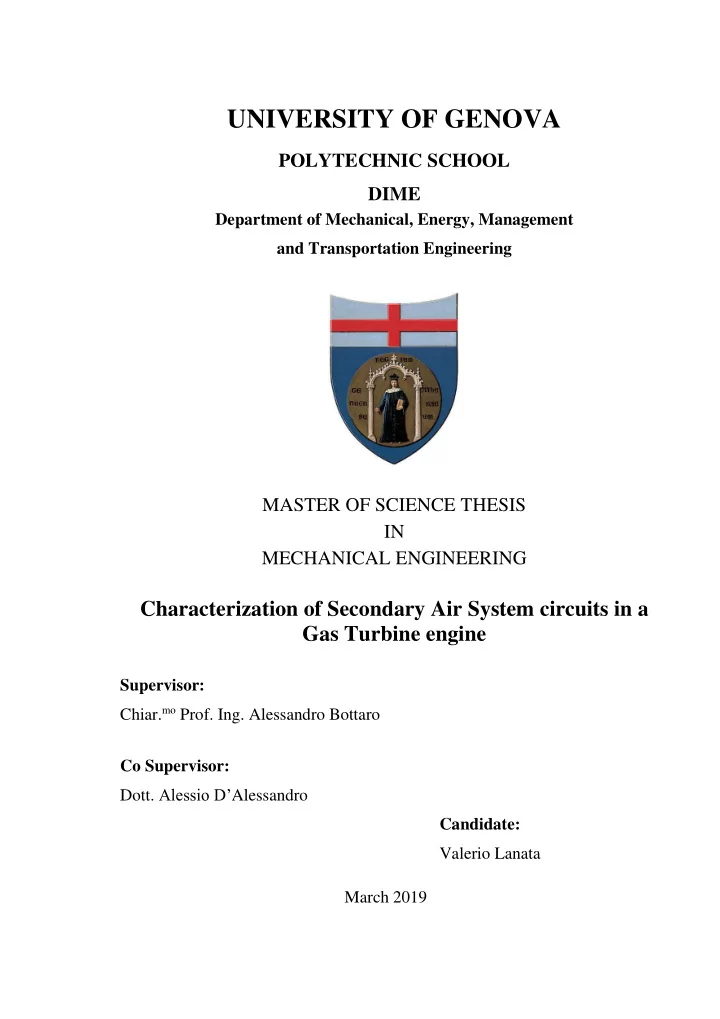

UNIVERSITY OF GENOVA POLYTECHNIC SCHOOL DIME Department of Mechanical, Energy, Management and Transportation Engineering MASTER OF SCIENCE THESIS IN MECHANICAL ENGINEERING Characterization of Secondary Air System circuits in a Gas Turbine engine Supervisor: Chiar. mo Prof. Ing. Alessandro Bottaro Co Supervisor: Dott. Alessio D’ Alessandro Candidate: Valerio Lanata March 2019
Caratterizzazione dei circuiti di Aria Secondaria di una turbina a gas Sommario All’interno del sempre più competitivo mercato degli impianti per l’energia , la necessità di un sistema integrato per la predizione delle performance di un impianto in condizioni nominali e di forte off- design è sempre maggiore. L’elaborato seguente si concentra sulla caratterizzazione dei circuiti d’aria secondaria di una turbin a a gas in suddette condizioni di off-design. Per poter simulare il comportamento dei circuiti di Aria Secondaria una rete fluida 0D è stata implementata in una routine basata sull’analisi dimensionale e sul teorema Π di Riabouchinsky-Buckingham. Basandosi su queste basi teoriche, il sistema utilizza i dati derivanti da varie simulazioni della rete fluida per generare le curve caratteristiche dei circuiti. Queste curve sono state generate in modo da poter essere associate con le curve caratteristiche degli altri componenti del turbogas. Le curve sono state inoltre suddivise in due macro contributi (Cooling e Leakage) e successivamente classificate per ottenere un’elevata risoluzione spaziale dei flussi d’iniezione in turbina . I
Characterization of Secondary Air System circuits in a Gas Turbine engine Abstract In a more and more competitive power market, the necessity of an integrated system for a plant’s performance predi ction, both in nominal and off-design conditions, is always greater. The following text is focused on the characterization of the Secondary air System circuits of a gas turbine engine, in the above mentioned off-design conditions. To simulate the behaviour of the Secondary Air circuits a 0D fluid network has been implemented in a routine based on the dimensional analysis and on the Riabouchinsky- Buckingham’s Π theorem. Basing on these theoretical fundaments, the system utilizes the data coming from many simu lations of the 0D fluid network to generate the Secondary Air System circuits’ characteristic curves. These characteristic curves have been defined in order to be interfaced with the other Gas Turbine components’ curves. The characteristic curves have been split in 2 macro-contributes (Cooling and Leakage) and subsequently classified to obtain an elevated spatial resolution of the turbine injection flows. II
Ringraziamenti Ringrazio innanzitutto il Prof. Ing. Alessandro Bottaro, insegnante appassionato ed ispiratore, che mi ha concesso l’op portunità di svolgere questa attività presso Ansaldo Energia. Ringrazio il Dott. Alessio D’Alessandro per la dispo nibilità, la cura dei dettagli e la professionalità con cui ha seguito l’intera attività. Ringrazio Andrea, Elena, Francesco, Marco, Roberto e Vera per avermi accolto nel loro gruppo, per aver corretto i miei errori e per avermi mostrato la passione che mettono nel loro lavoro. Ringrazio infine mia madre che dal primo giorno mi ha spronato a seguire i miei sogni, sempre pronta ad aiutarmi in qualsiasi modo. III
Contents Sommario ........................................................................................................................... I Abstract ............................................................................................................................ II Ringraziamenti ............................................................................................................... III 1. Introduction .................................................................................................................. 1 1.1 Gas Turbine introduction .................................................................................. 3 1.2 Basic Gas Turbine thermodynamics ................................................................. 3 1.3 Blade cooling .................................................................................................... 8 1.4 Energy market ................................................................................................. 10 2. Gas Turbine Secondary Air System ......................................................................... 13 2.1 Secondary air system main objectives ............................................................ 14 2.1.1 Turbine Blade Cooling ......................................................................... 14 2.1.2 Turbine Vane Cooling .......................................................................... 14 2.1.3 Turbine sealing system ......................................................................... 15 2.1.4 Rotor Axial Thrust Balance .................................................................. 21 2.1.5 Passive clearance control ...................................................................... 22 2.1.6 Leakages ............................................................................................... 23 2.1.7 Optimal and robust SAS design ............................................................ 24 3. Secondary Air System Numerical Integration ........................................................ 26 3.1 Secondary Air System network solver ........................................................... 26 3.2 CalculiX .......................................................................................................... 26 3.2.1 Newton-Raphson scheme ..................................................................... 27 3.2.2 Drawbacks of the Newton-Raphson Method ........................................ 29 3.2.3 Implementation ..................................................................................... 32 3.2.4 Convergence criteria ............................................................................. 36 3.2.5 User interface ........................................................................................ 37 4. Dimensional analysis on Secondary Air System ...................................................... 38 4.1 Dimensional analysis for Gas Turbines .......................................................... 38 IV
4.2 Dimensional analysis ...................................................................................... 38 4.2.1 Π Theorem ............................................................................................ 41 4.3 Π theorem applications ................................................................................... 42 4.4 Π theorem application to Secondary Air System ........................................... 43 4.5 Application of Blade and Vane Characteristic Curves ................................... 45 4.6 Characteristic curves matching ....................................................................... 47 4.7 Secondary Air System characteristic curves production ................................ 48 4.7.1 Internal lines ......................................................................................... 50 4.7.2 External lines ........................................................................................ 55 4.7.3 Pumping work ....................................................................................... 56 4.7.4 Design of Experiments ......................................................................... 56 4.7.5 Characteristic Curves Post Processing .................................................. 57 5. Fluid Network Assembly ........................................................................................... 58 5.1 Internal line assembling .................................................................................. 58 5.2 External line assembling ................................................................................. 66 6. Characteristic Curves Production ............................................................................ 76 7. Conclusions ................................................................................................................. 86 References ...................................................................................................................... 87 Nomenclature ................................................................................................................ 89 V
Recommend
More recommend